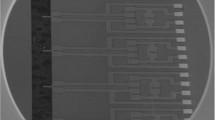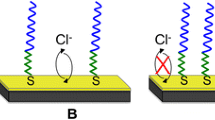Abstract
Cantilever is dramatically used as a resonator sensor to detect the presence of a particular molecule or cell in an environment and to measure their amount. Electrostatic force is commonly used to actuate MEMS based cantilevers to resonate because a cantilever has a simple capacitor structure. In this paper, a novel design is proposed to optimize the cantilevers performance by use of high dielectric material in its capacitor structure. The mathematical model of the proposed design and the performance of the cantilever sensor and its quality has been evaluated and reported by finite element simulations in this way.









Similar content being viewed by others
References
Priyanka, E. B., Thangavel, S., Prasad, P. H., & Mohanasundaram, R. (2021). IoT fusion based model predictive pid control approach for oil pipeline infrastructure. International Journal of Critical Infrastructure Protection, 35, 100485. https://doi.org/10.1016/j.ijcip.2021.100485
Devi, T. K., Priyanka, E. B., & Sakthivel, P. (2021). FPGA implementation of balanced biorthogonal multiwavelet using direct pipelined mapping method for image compression applications. Sensing and Imaging, 22(1), 1–19.
Ponnibala, M., Priyanka, E. B., & Thangavel, S. (2021). Proliferative diabetic retinopathy diagnostic investigation using retinal blood vessels mining technique. Sensing and Imaging, 22(1), 1–11. https://doi.org/10.1007/s11220-021-00331-9
Priyanka, E. B., Thangavel, S., & Kalavathidevi, T. (2021). Miniaturized antenna design for communication establishment of peer-to-peer communication in the oil pipelines. Petroleum Research, 6(3), 291–302. https://doi.org/10.1016/j.ptlrs.2021.04.003
Chennippan, M., Bhaskaran, P. E., Adhulrasheed, I. S. K., Subramaniam, T., & Govindasamy, R. (2020). Vibration signals based bearing defects identification through online monitoring using LABVIEW. Journal Européen des Systèmes Automatisés, 53(2), 187–193.
Priyanka, E.B. & Thangavel, S. (2020) Decision making based on machine learning algorithm for identifying failure rates in the oil transportation pipeline. In 2020 international conference on decision aid sciences and application (DASA, November, Sakheer, Bahrain, IEEE (pp. 914-919). doi:https://doi.org/10.1109/DASA51403.2020.9317180
Wang, J., Zhu, Y., & Wang, X. (2016). A high-throughput cantilever array sensor for multiple liver cancer biomarkers detection. Journal of IEEE Sensors, 16(12), 4675–4682. https://doi.org/10.1109/jsen.2016.2524515
Eidi, A., Ghavifekr, H. B., & Shamsi, M. (2019). A novel biosensor based on micromechanical resonator array for lab-on-a-chip applications. Journal of Sensing and Imaging, 20(39), 1–10. https://doi.org/10.1007/s11220-019-0261-z
Erismis, M. A., Pereira Neves, H., De Moor, P., Puers, R., & Van Hoof, C. (2010). A water-tight packaging of MEMS electrostatic actuators for biomedical applications. Microsystem Technologies, 16(12), 2109–2113. https://doi.org/10.1007/s00542-010-1136-3
Salehi, P., Yaghoobi, H., & Torabi, M. (2012). Erratum to: “Application of the differential transformation method and variational iteration method to large deformation of cantilever beams under point load.” Journal of Mechanical Science and Technology, 26(12), 3743–3743. https://doi.org/10.1007/s12206-012-1016-0
Korayem, M. H., & Sharahi, H. J. (2011). Analysis of the effect of mechanical properties of liquid and geometrical parameters of cantilever on the frequency response function of AFM. The International Journal of Advanced Manufacturing Technology, 57(5–8), 477–489. https://doi.org/10.1007/s00170-011-3321-7
Matović, J., & Jakšić, Z. (2010). A comparative analyze of fundamental noise in cantilever sensors based on lateral and longitudinal displacement: Case of thermal infrared detectors. Microsystem Technologies, 16(5), 755–763. https://doi.org/10.1007/s00542-010-1052-6
Anik’ev, I. I., Maksimyuk, V. A., Mikhailova, M. I., & Sushchenko, E. A. (2014). The reaction of an elastic cantilever-rod system to Quasistatic and shock-wave loads. International Applied Mechanics, 50(1), 75–78. https://doi.org/10.1007/s10778-014-0612-3
Liu, W., Han, M., Meng, B., Sun, X., Huang, X., & Zhang, H. (2014). Low frequency wide bandwidth MEMS energy harvester based on spiral-shaped PVDF cantilever. Science China Technological Sciences, 57(6), 1068–1072. https://doi.org/10.1007/s11431-014-5511-7
He, J., Xie, J., He, X., Du, L., Zhou, W., & Hu, Z. (2015). Analytical and high accurate formula for electrostatic force of comb-actuators with ground substrate. Microsystem Technologies, 22(2), 255–260. https://doi.org/10.1007/s00542-015-2412-z
Kamiya, D., Hayama, T., & Horie, M. (1999). Electrostatic comb-drive actuators made of polyimide for actuating micromotion convert mechanisms. Microsystem Technologies, 5(4), 161–165. https://doi.org/10.1007/s005420050157
Hailu, Z., He, S., & Ben Mrad, R. (2015). Hybrid micro electrostatic actuator. Microsystem Technologies, 22(2), 319–327. https://doi.org/10.1007/s00542-015-2424-8
Tsou, C. (2006). The design and simulation of a novel out-of-plane micro electrostatic actuator. Microsystem Technologies, 12(8), 723–729. https://doi.org/10.1007/s00542-006-0107-1
Afrang, S., & Nematkhah, N. (2019). A new MEMS based variable capacitor using electrostatic vertical comb drive actuator and auxiliary cantilever beams. Microsystem Technologies, 25(9), 3317–3327. https://doi.org/10.1007/s00542-019-04293-7
Pham, P. H., Hoang, K. T., & Nguyen, D. Q. (2019). Trapezoidal-shaped electrostatic comb-drive actuator with large displacement and high driving force density. Microsystem Technologies, 25(8), 3111–3118. https://doi.org/10.1007/s00542-019-04315-4
Sauerbrey, G. (1959). Verwendung von schwingquarzen zur wägung dünner schichten und zur mikrowägung. Zeitschrift für physik, 155(1), 206–222.
Takahashi, H., Dung, N. M., Matsumoto, K., & Shimoyama, I. (2012). Differential pressure sensor using a piezoresistive cantilever. Journal of Micromechanics and Microengineering., 22(36), 1–30. https://doi.org/10.1088/0960-1317/22/5/055015
Toda, M., Inomata, N., Ono, T., & Voiculescu, I. (2017). Cantilever beam temperature sensors for biological applications. IEEJ Transactions on Electrical and Electronic Engineering., 12(2), 153–160. https://doi.org/10.1002/tee.22360
Baller, M. K., Lang, H. P., Fritz, J., Gerber, C., Gimzewski, J. K., Drechsler, U., Rothuizen, H., Despont, M., Vettiger, P., Battiston, F. M., & Ramseyer, J. P. (2000). A cantilever array-based artificial nose. Ultramicroscopy., 82(1–4), 1–9. https://doi.org/10.1016/S0304-3991(99)00123-0
Lang, H. P., Hegner, M., & Gerber, C. (2005). Cantilever array sensors. Materialstoday, 8(4), 30–36. https://doi.org/10.1016/S1369-7021(05)00792-3
Su, M., Li, S., & Dravid, V. P. (2003). Microcantilever resonance-based DNA detection with nanoparticle probes. Applied Physics Letters, 82(20), 3562–3564.
Baek, K. H., Seo, Y.-T., Bang, Y.-S., Lee, D., Kim, J.-M., & Kim, Y. K. (2011). Design, fabrication and characterization of piezoelectric micro-cantilever operated in liquid environment for ultrasound energy source applications. Microsystem Technologies, 17(8), 1319–1327. https://doi.org/10.1007/s00542-011-1292-0
Al-Gayem, Q., Liu, H., Richardson, A., & Burd, N. (2011). Test strategies for electrode degradation in bio-fluidic microsystems. Journal of Electronic Testing, 27(1), 57–68. https://doi.org/10.1007/s10836-010-5180-9
De Cezaro, A. M., Ballen, S. C., Hoehne, L., Steffens, J., & Steffens, C. (2021). Cantilever nanobiosensors applied for endocrine disruptor detection in water: A review. Water, Air, & Soil Pollution. https://doi.org/10.1007/s11270-021-05179-z
Rodrigues, L. F., Ierich, J. C. M., Andrade, M. A., Hausen, M. A., Leite, F. L., Moreau, A. L. D., & Stefens, C. (2017). Nanomechanical cantilever-based sensor: An efcient tool to measure the binding between the herbicide mesotrione and 4-hydroxyphenylpyruvate dioxygenase. NANO, 12(07), 1750079. https://doi.org/10.1142/S1793292017500795
Stefens, C., Leite, F. L., Manzoli, A., Sandoval, R. D., Fatibello, O., & Herrmann, P. S. P. (2014). Microcantilever sensors coated with a sensitive polyaniline layer for detecting volatile organic compounds. Journal of Nanoscience and Nanotechnology. https://doi.org/10.1166/jnn.2014.9348
Stefens, C., Corazza, M. L., Franceschi, E., Castilhos, F., Herrmann, P. S. P., & Oliveira, J. V. (2012). Development of gas sensors coatings by polyaniline using pressurized fluid. Sensors and Actuators, B: Chemical, 171–172, 627–633. https://doi.org/10.1016/j.snb.2012.05.044
Stefens, C., Leite, F. L., Bueno, C. C., Manzoli, A., & Herrmann, P. S. P. (2012). Atomic force microscopy as a tool applied to Nano/Biosensors. Sensors, 12(6), 8278–8300. https://doi.org/10.3390/s120608278
Subramanian, M. A., Li, D., Duan, N., Reisner, B. A., & Sleight, A. W. (2000). High dielectric constant in ACu3Ti4O12 and ACu3Ti3FeO12 phases. Journal of Solid State Chemistry, 151(2), 323–325. https://doi.org/10.1006/jssc.2000.8703
Hsu, C. T., Su, Y. K., & Yokoyama, M. (1992). High dielectric constant of RF-sputtered HfO2 thin films. Japanese Journal of Applied Physics, 31(8), 2501–2504. https://doi.org/10.1143/jjap.31.2501
Crippa, M., Bianchi, A., Cristofori, D., D’Arienzo, M., Merletti, F., Morazzoni, F., Scotti, R., & Simonutti, R. (2013). High dielectric constant rutile–polystyrene composite with enhanced percolative threshold. Journal of Materials Chemistry C, 1(3), 484–492. https://doi.org/10.1039/c2tc00042c
Author information
Authors and Affiliations
Corresponding author
Additional information
Publisher's Note
Springer Nature remains neutral with regard to jurisdictional claims in published maps and institutional affiliations.
Rights and permissions
About this article
Cite this article
Eidi, A. Optimized Cantilever Sensor Based on Parallel High Dielectric Material. Sens Imaging 23, 13 (2022). https://doi.org/10.1007/s11220-022-00381-7
Received:
Revised:
Accepted:
Published:
DOI: https://doi.org/10.1007/s11220-022-00381-7




